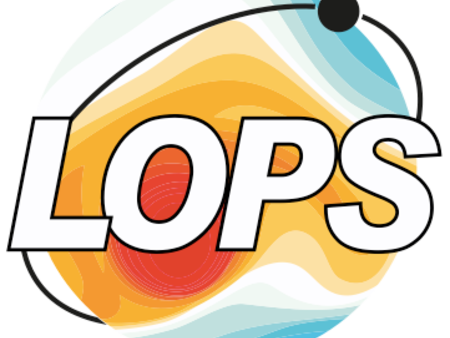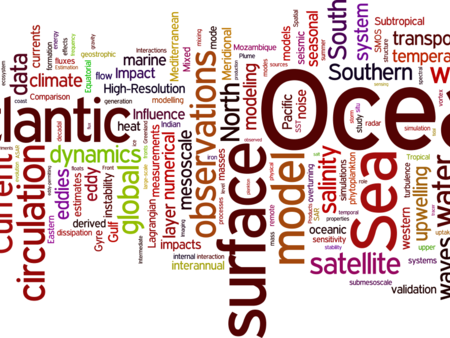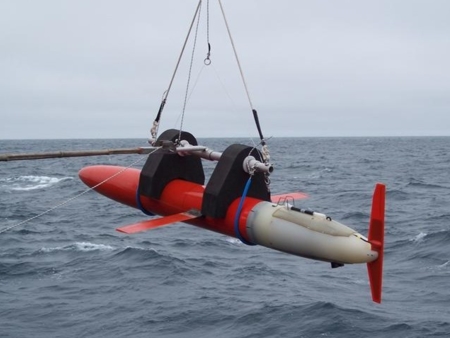ANDRO : An Argo-based deep displacement dataset
ANDRO Argo floats displacements
What is ANDRO ?
In 2000, the international Argo observational program was launched by the IOC and WMO to observe the global in situ ocean temperature and salinity, in order to monitor the ocean's variability and understand its role in climate. To reach this scientific goal, the prerequisite was to provide near-real time profiles of ocean state parameters every 10 days for each 3x3 degrees area of the global ocean. This corresponds to about 3000 floats operating permanently at sea (Riser et al., 2016). Given the autonomous floats technology available at the beginning of the program in 2000, parameters were limited to pressure, temperature and salinity, sampling depth was limited to the first 2000m of the water column and sampling area was limited to the open ocean, away from marginal seas as well as high latitudes. It took about 8 years for the international community to reach this sampling target (from 2000 to the end of 2007). Then, more than ten years later (2018), more than 2 millions quality controlled profiles have been provided, overwhelming in one decade the amount of profiles ever carried out in the history of oceanography. The Argo program is now the backbone of in situ Global Ocean Observing System (GOOS). Hence revolutionizes our vision and understanding of the ocean in unexpected ways day after day. Eventually, Argo is a major contributor to operational oceanography to assimilate in models of ocean reanalysis and forecast, and to validate oceanic and atmospheric models for climate predictions.
Figure 1: 1000 dbar deep currents in the Southern Hemisphere estimated from Argo floats parking depth displacement from the ANDRO dataset (from Ollitrault and Rannou, 2013)
In addition to the major increase in temperature and salinity profile of high quality, Argo autonomous floats are cycling between surface and their nominal parking depth at 1000 dbar, where they drift during 10 days. Thus, through the positioning of the float at surface, they provide an unprecedented integrated huge dataset of trajectories, thus horizontal velocities at 1000 dbar (Figure 1) and at the surface. These deep velocities provide unprecedented absolute references used to reconstruct ocean currents products, to constrained and validate model reanalyses and climate models, such as constrain the earth geoid reference for satellite altimeters measurements. In contrast to the sparse sampling of currentimeters provided by scientific cruises and few equipped mooring at few locations, the Argo float trajectories are unique sources of velocity data since the coverage is global and more than 20 years of data are available. Thus, it could provide robust constraints for data assimilation and model validation, as well as data for scientific studies.
Although the trajectory real time data are freely available in real time through the Argo GDAC, no quality controls are performed on this dataset. Currently, the Argo ADMT does not provide any recommendation for Delayed Mode QC on this data. Thus, real time Argo trajectory files are often poorly documented and filled, and data quality is subject to caution.
Figure 2: Schematics of an Argo float cycle. An Argo cycle consists of five main phases: descent, park, deep descent, profile, and surface telemetry. Associated times are descent start time (DST), first stabilization time (FST), descent end time (DET), deep descent start time (DDST), deep descent end time (DDET), ascent start time (AST), ascent end time (AET), transmission start time (TST), and transmission end time (TET). First message time (FMT) and last message time (LMT) indicate the times of the first and last messages collected by the (Argos, Iridium, or OrbComm) satellite system while the float is emitting at the surface. First location time (FLT) and last location time (LLT) indicate the times of the first and last available surface float lo-cations (from Argos or GPS). (From Ollitrault and Rannou, JAOT, 2013)
Andro Dataset
Since 2010, ANDRO products is the only one product to gather high quality delayed mode trajectories and velocity Argo data (https://doi.org/10.17882/47077).A world deep displacement dataset, named ANDRO, after a traditional dance of Brittany meaning a swirl, comprising more than 1200 000 deep displacements, has been produced from the Argo float data. ANDRO dataset was completed over the period 2000-2009, then was partially but yearly updated since 2010.
One important feature of ANDRO is that the pressures measured during float drifts at depth, and suitably averaged are preserved in ANDRO (see Figure 2). To reach this goal, it was necessary to reprocess most of the Argo raw data, because of the many different decoding versions (roughly 100) not always applied by the DACs to the displacement data because they were mainly interested in the p,t,S profiles. The result of our work was the production of comprehensive files, named DEP (for déplacements in French), containing all the possibly retrievable float data.
The procedure and tools for delayed mode control and data curation have been created by Michel Ollitrault (LPO, IFREMER, France) & Jean-Philippe Rannou (ALTRAN, France) (Ollitault and Rannou, JAOT, 2013) and developed and maintained in the framework of academic and industrial partnership among LOPS/SNO Argo, Ifremer/Coriolis and Altran company.
Figure 3: Number of Argo floats from GDAC processed in ANDRO in 2021.
However, as the Argo global GDAC is continuously enriched with new trajectory files, a significant gap in ANDRO data processing is still pending (Figure 3). Currently, more than 1 million of Argo floats displacement have been processed and included in the ANDRO database with a relative homogenous global coverage (Figure 4).
Figure 4: Density and coverage of ANDRO dataset in 2021 (in number of displacement by degree squared).
Data Access
The data are freely available through the doi (to be cited) :
Ollitrault Michel, Rannou Philippe, Brion Emilie, Cabanes Cecile, Piron Anne, Reverdin Gilles, Kolodziejczyk Nicolas (2021). ANDRO: An Argo-based deep displacement dataset. SEANOE. https://doi.org/10.17882/47077
ANDRO published reference :
Ollitrault, M., & Rannou, J. (2013). ANDRO: An Argo-Based Deep Displacement Dataset, Journal of Atmospheric and Oceanic Technology, 30(4), 759-788. Retrieved Jan 5, 2022, from https://journals.ametsoc.org/view/journals/atot/30/4/jtech-d-12-00073_1.xml
Please acknowledge :
"ANDRO argo floats displacements product is made freely available by SNO Argo France at LOPS Laboratory (supported by UBO/CNRS/Ifremer/IRD) and IUEM Observatory (OSU IUEM/CNRS/INSU), and was funded by Ifremer, Coriolis, SOERE-CTDO2 and SNO Argo France at doi: https://doi.org/10.17882/47077"
The ANDRO product is provided 'as it' with no garanties of any kind, thus any feedback will be welcomed:
Mail to cecile.cabanes@ifremer.fr ; nicolas.kolodziejczyk@univ-brest.fr ; jean-philippe.rannou@altran.com
Data sources and notes:
Argo public NetCDF files are found on any of the two Global Data Assembly Center websites (http://www.usgodae.org/argo/ or http://www.coriolis.eu.org/).
Using this then available Argo data, Yoshinari, Maximenko & Hacker, at the University of Hawaii first produced an atlas of velocity estimates (YoMaHa’05), in 2006. This atlas is regularly updated (YoMaHa’07) using the latest Argo public NetCDF files (http://apdrc.soest.hawaii.edu/projects/Argo/data/trjctry/). However the parking pressure is given as the nominal pressure, not the measured one, which may result in an error.
Fortunately, the DACs are presently implementing a detailed trajectory file format (for containing all the measured pressure at depth, …), following much of our DEP file format. It is hoped that this will permit, in the future, an easy update of ANDRO as well as a refinement of YoMaHa’07.







